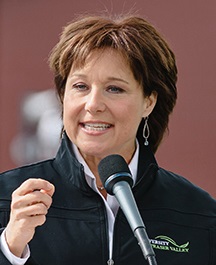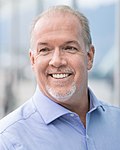Top Qs
Timeline
Chat
Perspective
2017 British Columbia general election
Canadian provincial election From Wikipedia, the free encyclopedia
Remove ads
The 2017 British Columbia general election was held on May 9, 2017, to elect 87 members (MLAs) to the Legislative Assembly to serve in the 41st Parliament of the Canadian province of British Columbia. In the 40th Parliament prior to this general election, the British Columbia Liberal Party formed the government under the leadership of Christy Clark, while the British Columbia New Democratic Party (NDP), under the leadership of Adrian Dix and then John Horgan, formed the Official Opposition; the Green Party of British Columbia were also represented in the legislature with sole MLA and later leader Andrew Weaver.
It was the first election contested on a new electoral map completed in 2015, and the total number of constituencies had increased from 85 to 87. New districts were added in Richmond and Surrey, while the boundaries of 48 existing electoral districts were adjusted.
The election saw no party win a majority of seats for the first time since the 1952 election: the Liberals won 43 seats, the NDP won 41 seats and the Greens won three seats. From 1952 to 2017, especially in the 2005 to 2017 period, often a single party that had not received a majority of the votes cast had achieved a majority of seats and held power.[5][6]
As no one party held a majority of seats, a working majority had to be forged. After a period of negotiating, on May 29 Green Party leaders agreed to provide confidence and supply to an NDP government. Clark meanwhile indicated she would remain in office and seek the confidence of the legislature. On June 29, the opposition MLAs voted against Clark's speech from the throne, and Lieutenant Governor Judith Guichon invited NDP leader Horgan to form a government. On July 18, Horgan became the new premier. The Greens maintained the NDP government in power, although Weaver and the other Green MLAs did not join the cabinet and were not given any official roles in the government.
The election was notable in that it marked the end of the Liberal majority government that had led the province since the 2001 election, and the first election in Canada at the federal or provincial level that saw more than one member of a Green party elected.[7][8]
Remove ads
Redistribution of ridings
An act was passed in 2015 providing for an increase of seats from 85 to 87, upon the next election.[9] The following changes were made:
- Also taking in part of Comox Valley.
- Parts went to Fraser-Nicola and West Vancouver-Sea to Sky.
- Also taking in part of Juan de Fuca.
- Also taking in part of Surrey-Whalley.
- From parts of Surrey-Cloverdale and Surrey-Panorama.
- Also taking in part of New Westminster.
- Also taking in part of Richmond-Steveston.
Remove ads
Timing
Section 23 of British Columbia's Constitution Act provides that general elections occur on the second Tuesday in May of the fourth calendar year after the last election.[10] As an election was held on May 14, 2013, the subsequent election was conducted on May 9, 2017. The same section, though, makes the fixed election date subject to the Lieutenant Governor's right to dissolve the Legislative Assembly as he or she sees fit (in practice, on the advice of the Premier).[10]
The writ was dropped on April 11, 2017.[11] Advance voter registration ended April 11. Advance voting was from April 29 to 30, then began again May 3 and lasted until May 6 before the general election on May 9.[12]
Remove ads
Background
Summarize
Perspective
In the 2013 general election, the BC Liberal Party under the leadership of Premier Christy Clark were re-elected with a majority government. The British Columbia New Democratic Party, under the leadership of Adrian Dix, again formed the Official Opposition with a slightly reduced total of 34 seats. Despite the victory, Clark was defeated by NDP candidate David Eby in her riding of Vancouver-Point Grey but was later elected in the Westside-Kelowna riding by-election in July 2013 following Ben Stewart's resignation of his seat the previous month so that she could return to the Legislature.[13] The Green Party, under leader Jane Sterk, won its first seat in the legislature, though Sterk herself was not elected. Dix resigned as NDP leader following the election and was succeeded by Horgan in the NDP 2014 leadership election.[14] On August 13, 2013, Sterk announced she would resign as Green Party leader;[15] Adam Olsen was appointed interim leader on August 25, 2013.[16] The Conservative Party, under the leadership of John Cummins, failed to win a seat and Cummins resigned after the Westside-Kelowna by-election. On February 2, 2016, two by-elections occurred in Vancouver-Mount Pleasant and Coquitlam-Burke Mountain to replace Jenny Kwan and Douglas Horne, who had both resigned to seek election in the 2015 Canadian federal election.
In preparation for the 2017 provincial election, the Electoral Boundaries Commission Amendment Act, 2014 increased the number of electoral districts from 85 to 87 and required that the number of electoral districts in the North, Cariboo-Thompson, and the Columbia-Kootenay regions not be decreased despite their lower populations since the last adjustment of electoral boundaries. The Electoral Districts Act was updated in November 2015 to establish the new electoral districts, adding one new electoral district in Surrey and one in Richmond. Additionally, the boundaries of 48 existing electoral districts were adjusted.[17]
The Election Amendment Act, 2015 required the chief electoral officer to provide each party with a copy of the voters list, allowed constituency associations to incur election expenses, limited vouching to amend voter information to only family members of the voter, and eliminated the 60-day pre-campaign period, including its expense limits.[18]
Remove ads
Election spending and fundraising
Summarize
Perspective
According to Elections BC, each candidate's campaign may spend a maximum of $77,674 over the 28 day election period and each political party, in addition, may spend $4,882,405. Also, each third party advertiser may spend up to $3,329 in a single electoral district and up to $166,445 overall.[19]
Unlike the Federal government or most provinces, British Columbia has no limits on political donations.[20][21] Wealthy individuals, corporations, unions and even foreigners are allowed to donate large amounts to political parties there.[22] On January 13, 2017, the New York Times published a story calling British Columbia the "Wild West" of Canadian political cash.[22] According to the New York Times, "critics of [Premier Clark] and her party, the conservative British Columbia Liberal Party, say the provincial government has been transformed into a lucrative business, dominated by special interests that trade donations for political favors, undermining Canada's reputation for functional, consensus-driven democracy."[22] The article also explored Premier Clark's practice of taking an additional salary from the BC Liberals, beyond her Premier salary, financed by political contributions.[22] The Globe and Mail also followed up with a special investigation of "British Columbia: The 'wild west' of fundraising".[20] The investigation found that lobbyists are giving tens of thousands of dollars in their own name – and some power brokers are breaking one of the few rules the province has in place.[20] With no limits on political donations in BC, the provincial Liberals raised $12.4 million last year – $4.5-million from individuals and $7.9-million from corporations.[20][23]
On March 5, 2017, Elections BC announced it was launching a probe into Liberal Party fundraising.[24] The Official Opposition, the NDP, has promised to ban corporate and union donation if elected, as well as limits on individual donations, but continues to accept corporate and union donations at the present time.[23] The Green Party announced in September 2016 that it would no longer accept donations from corporations or unions.[25]
In terms of election spending, British Columbia currently has no spending limits ahead of the election period. During the 2009 election period, there was a spending limit of $4.4 million.[26] Spending limits for the 2017 election period were adjusted for changes to the consumer price index before being confirmed during the second week in April 2017.[27][19]
Remove ads
Opinion polls
Remove ads
Endorsements
Green Party
Liberal Party
Retiring incumbents
Remove ads
Results
Remove ads
MLAs elected
Summarize
Perspective
|
|
Synopsis of results
- Including spoilt ballots
- Parties receiving more than 1% of the popular vote, or fielding candidates in at least half of the constituencies, are listed separately. Conservatives are also shown separately, as they had been a significant player in 2013, and Libertarians are noted due to the number of candidates fielded in this election.
- Alana DeLong was previously a Progressive Conservative member of the Legislative Assembly of Alberta.
- = Open seat
- = turnout is above provincial average
- = winning candidate was in previous Legislature
- = Incumbent had switched allegiance
- = Previously incumbent in another riding
- = Not incumbent; was previously elected to the Legislature
- = Incumbency arose from by-election gain
- = other incumbents renominated
- = previously an MP in the House of Commons of Canada
- = Multiple candidates
Summary analysis
Remove ads
Aftermath
Summarize
Perspective
On May 9, it was not immediately clear what form the government would take, as Elections BC does not count absentee ballots until two weeks after election day. This final count would determine the makeup of the legislature, since several seats were won with margins of a few hundred votes or less, and both the Liberals and NDP hoped to acquire enough seats to secure a majority.[90] No seats changed hands, however, after the counting of absentee ballots concluded on May 24, and the initial count of 43–41–3 was confirmed.[91]
As no single party won a majority of seats, the Green Party was approached by both the Liberals and the NDP to determine whether they would support a minority government or a coalition government headed by either party.[92] No grand coalition or agreement between the two large parties, excluding the Greens, was seriously considered. On May 29, Horgan and Weaver announced that the Greens would provide confidence and supply to an NDP minority government, a position which was endorsed the following day by the members of both caucuses.[93] In response, Clark indicated that she would have the legislature sit in the coming weeks and seek its confidence in a Liberal minority government, while acknowledging that she would likely be unsuccessful.[94] On June 12, Clark appointed a new cabinet that saw new MLAs join cabinet and existing ones take on different portfolios; Clark described the cabinet as being in "caretaker mode" and that it wouldn't pursue any new policies, but added "the team reflects the results of listening to what voters told us in the last election."[95] On June 22, the legislature convened with a throne speech that Clark said contained "the best ideas from all parties"; of the 48 pledges within, 30 were absent from the Liberal Party's election platform.[96] On June 29, the Liberals were defeated in a confidence vote; Clark then asked Lieutenant Governor Judith Guichon to dissolve the legislature and call a new election. Guichon refused and instead invited Horgan to form an NDP minority government.[97][4][98] Horgan was sworn into office on July 18.[99]
Remove ads
Student vote results
Student votes are mock elections that run parallel to actual elections, in which students not of voting age participate. They are administered by Student Vote Canada. Student vote elections are for educational purposes and do not count towards the results.
Remove ads
Footnotes
- Following the election, Christy Clark's Liberal minority government was sworn in. On June 29, 2017, Clark's government was defeated in a confidence vote, prompting her resignation. Lieutenant Governor Judith Guichon then invited NDP leader John Horgan to form a minority government with Green support. Clark's resignation was effective July 18, 2017, at which time Horgan was sworn in as premier.[4]
References
Further reading
External links
Wikiwand - on
Seamless Wikipedia browsing. On steroids.
Remove ads




